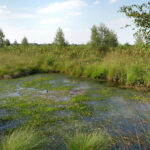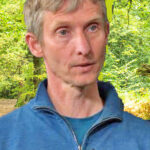Op 14 januari schreef Marcel Crok het artikel “Peer review is dood, leven peer-2-peer review“. Daarmee zette hij voor Nederland een nieuw fenomeen op de kaart. Als alles zich voorspoedig ontwikkelt zullen Climategate.nl en mogelijke spin-offs peer-2-peer review in Nederland gaan faciliteren. Waarbij ik aanteken dat Marcel’s titel suggestief was en dat dit nieuwe (oude wijn in nieuwe vaten) fenomeen niet bedoeld is ter vervanging van peer review, maar als waakhond wanneer peer review in een bepaald onderzoeksveld is verworden tot pal review.
Voor ik mijn onderzoek naar peer-2-peer review en post-normale wetenschap begin, roep ik een voorbeeld van peer-2-peer review in herinnering op de website die deze controlerende vijfde macht (de vierde macht is de traditionele journalistiek) internationaal belichaamt: Wattsupwiththat.com.
Caleb
We gaan terug naar 27 september 2009: Steven McIntyre blaast het kaartenhuis van de Yamal boomringen om. Zijn website raakt overbelast. Wattsupwiththat.com neemt het artikel over (link). Goed voor 164 reacties. Op 1 oktober reageert ene Caleb. Hij opent zijn hieronder integraal weergegeven analyse alsvolgt:
I’ve worked outside since I was a small boy in the 1950’s, and have cut down hundreds of trees. I always check out the rings, for every tree has its own story….
Lumineus en broodnodig inzicht
Anthony Watts is zo geboeid door de kwaliteit van de reactie van deze Phd-loze bosbouwer (locatie originele reactie), dat hij besluit er een apart bericht aan te wijden. Hij geeft het artikel de toepasselijke titel mee: A hands on view of tree growth and tree rings. En dat is het! Een bericht van een man die op basis van bloed, zweet en tranen meer weet van bomen en boomringen dan een wetenschapper ooit zal weten. Een visie die in een gezonde wetenschapsbeoefening weinig zou toevoegen en daar hoogstens waarde als anekdote zou hebben. Maar voor volgers van de zwaar uit balans geraakte klimaatwetenschap is zijn optiek ineens een lumineus en broodnodig extern inzicht.
Anthony Watts introduceert Caleb als volgt:
One of the great things about WUWT is that people from all walks of life frequent here. We have PhD’s right down to Average Joe that read and post comments here. Everyone has something to contribute.
A general truism that I’ve noticed through life is that the people that actually work “hands on” with the things they study often know far more about them than the people that study them from afar.
Laat dit de aftrap zijn voor mijn onderzoekje naar peer-2-peer review en post-normale wetenschap, dat ik mede uitvoer in de hoop dat de reacties en gastblogs op deze website zich verder in deze richting gaan bewegen. Hieronder als eerbetoon integraal de tekst van de reactie van Caleb:
Guest comment by Caleb Shaw:
I’ve worked outside since I was a small boy in the 1950’s, and have cut down hundreds of trees. I always check out the rings, for every tree has its own story.
I’ve seen some rather neat tricks pulled off by trees, especially concerning how far they can reach with their roots to find fertilizer or moisture. For example, sugar maple roots will reach, in some cases, well over a hundred feet, and grow a swift net of roots in the peat moss surrounding a lady’s azalea’s root ball, so that the azalea withers, for the maple steals all its water.
I’ve also seen tired old maples perk right up, when a pile of manure is heaped out in a pasture a hundred feet away, and later have seen the tree’s rings, when it was cut down, show its growth surged while that manure was available.
After fifty years you learn a thing or two, even if you don’t take any science classes or major in climatology, and I’ve had a hunch many of the tree-ring theories were bunkum, right from the start.
The bristlecone records seemed a lousy proxy, because at the altitude where they grow it is below freezing nearly every night, and daytime temperatures are only above freezing for something like 10% of the year. They live on the borderline of existence, for trees, because trees go dormant when water freezes. (As soon as it drops below freezing the sap stops dripping into the sugar maple buckets.) Therefore the bristlecone pines were dormant 90% of all days and 99% of all nights, in a sense failing to collect temperature data all that time, yet they were supposedly a very important proxy for the entire planet. To that I just muttered “bunkum.”
But there were other trees in other places. I was skeptical about the data, but until I saw so much was based on a single tree, YAD061, I couldn’t be sure I could just say “bunkum.”
YAD061 looks very much like a tree that grew up in the shade of its elders, and therefore grew slowly, until age or ice-storms or insects removed the elders and the shade. Then, with sunshine and the rotting remains of its elders to feed it, the tree could take off.
I have seen growth patterns much like YAD061 in the rings of many stumps in New Hampshire, and not once have I thought it showed a sign of global warming, or of increased levels of CO2 in the air. Rather the cause is far more simple: A childhood in the under-story, followed by a tree’s “day in the sun.”
Dr. Briffa should spend less time gazing at computer screens, and actually get out and associate with trees more. At the very least, it might be good for his health.






Juist in de wetenschapsfilosofie kennen we het aspect dat Caleb Shaw zo duidelijk relateert aan het door hem gesignaleerde probleem: tacit knowledge. Kennis die niet alleen in het hoofd maar ook in de handen zit. De beroemde chemicus en wetenschapsfilosoof Michael Polanyi is er beroemd mee geworden in zijn boek 'Personal Knowledge'. Onderzoekers hebben veel meer nodig dan boekenwijsheid. Vaardigheden (skills) zijn van wezenlijk belang om als onderzoeker te slagen.
De kennis die wordt opgedaan in de praktijk -leren observeren, begrijpen wat je ziet, ervaring op doen- is van onschatbare waarde in het doen van goed wetenschappelijk onderzoek. Dat kan niet worden afgedaan als anecdotisch. Integendeel. Het is een opeenstapeling van veel ervaring en daarmee kennis, bomen en bossen in het geval van Shaw.
Ik heb 'tacit knowledge' aan het werk gezien in mijn studie naar zure regen in de jaren 90. De bossen gingen dood in de jaren 70 en 80 van de vorige eeuw, aldus veel onderzoekers. Het was de 'klimaatapocalypse' van 30 jaar geleden.
In gesprek met bosbouwers, mensen die zoals Shaw dag en nacht in bossen doorbrengen, kwam een heel ander verhaal naar boven. Zij observeerden helemaal geen achteruitgang in het areaal en de kwaliteit van de bossen.
Hun kennis en kunde bleek hen gelijk te geven. De bossen zijn niet gestorven aan zure regen.
Meneer Hanekamp, het waren toch ook (vooral) de zandsteen beelden etc. zoals die van de middeleeuwse kathedralen etc, die wegsmolten door zure regen? En zou dat gelegen kunnen hebben aan de zwavel etc. van de uitlaatgassen en smog, juist aanwezig in de groeiende steden met toenemende industrie en autoverkeer?
Wat ik al zo vaak heb gezegd, de meeste AGW klimaatwetenschappers zitten in een ivoren toren. Dit betreft zowel de wetenschap als het groeps(doem)denken in deze groep.
"Zij observeerden helemaal geen achteruitgang in het areaal en de kwaliteit van de bossen."
Als ik het goed heb was grote droogte toch de oorzaak?
Toch hoef je niet altijd praktijk ervaring te hebben. In 1992 bracht de journalist Karel Beckman een boek uit met de titel: Het Broeikaseffect Bestaat Niet – De mythe van de ondergang van het milieu.
Hierin maakt hij korte metten met o.a. het verhaal over de zure regen. Lees ook zijn commentaar van jaren later: http://www.charlieville.nl/index.php?option=com_c…
Met dit boek was hij zijn tijd ver vooruit. Op de site hierboven vindt u ook links naar recente artikelen van hem.
Volgens mij was dat verhaal van die boomringen van Yamal ietsje anders:
http://deepclimate.org/2009/10/07/let-the-backped… http://deepclimate.org/2009/10/06/delayed-oscilla…
Kwam ook nog bij dat McIntyre de data al had, maar toch Briffa om de data bleef vragen, terwijl Briffa hem al had meegedeeld dat hij bij de russen moest zijn.
In een eerdere post had ik al aangegeven Watts niet het slimste jongetje van de klas is:
http://tamino.wordpress.com/2010/03/05/message-to…
Als dat de standaard van peer-2-peer review wordt, dan is het hek van de dam en staat de weg open naar pseudowetenschap.
Kostelijk (lees: dodelijk) is deze fout van Watts:
http://tamino.wordpress.com/2008/04/01/how-not-to…
En wie het niet snapt het is iets met sorteren in excell.
Snap je het nog niet, dan is het Dunning-Kruger effect van toepassing:
http://en.wikipedia.org/wiki/Dunning%E2%80%93Krug…
Volgens mij was dat verhaal van die boomringen van Yamal
ietsje anders, of lees deze.
Kwam ook nog bij dat McIntyre de data al had, maar toch Briffa om de data bleef vragen, terwijl Briffa hem al had meegedeeld dat hij bij de russen moest zijn.
Als een blog als Watts de standaard van peer-2-peer review wordt, dan is het hek van de dam en staat de weg open naar pseudowetenschap.
In een eerdere post had ik al aangegeven dat Watts niet het slimste jongetje van de klas is.
Kostelijk (lees: dodelijk) is deze fout van Watts.
(Tip: wie het niet snapt het is iets met sorteren in excel…).
Snap je het nog niet, dan ben ik bang dat het Dunning-Kruger effect van toepassing is.
Het doet niet af aan wat deze boswachter (?) Caleb beweert: dat er zo veel andere mestal niet meer zo makkelijk achterhaalbare factoren een rol spelen bij de dikte van boomringen, dat ze volledig onbruikbaar zijn als maat voor opwarming en dus voor klimaat- en temperatuurreconstructie.
Maar vreemd dat dit nog aan u moet worden uitgelegd. Het 'hiding the decline' toonde al aan dat mensen als Briffa en Mann er geen moeite mee hadden de boomringen soms wel en soms niet te gebruiken als proxy. Wel als het andere gegevens of beter interpretaties van andere gegevens kon bevestigen, niet als het die andere gegevens weersprak. Uit de gegevens die zij bij elkaar gesprokkeld hadden, was maar één goede conclusie mogelijk geweest: boomringen zijn hoogst onbetrouwbare proxies.
Het probleem is niet alleen dat wetenschappers niet meer buiten spelen maar dat zij binnen op basis van gebrekkige kennis en kunde modellen maken van de werkelijkheid en die als juist gaan zien.
Tot zover nog geen probleem maar als vervolgens de waarnemingen uit de praktijk worden afgeserveerd/genegeerd als onjuist is het de wereld op zijn kop.
Het is echter wel de manier om fondsen vrij te maken voor "DEZE ENIGE EN ECHTE WETENSCHAP"
@vanderlaan
Het slimste jongetje van de klas is natuurlijk Phil-Excellent-Jones, die zelf geen trend line kan uitrekenen: "I’m not adept enough (totally inept) with excel to do this now as no-one who knows how to is here.
@JvanderLaan: Ietsje 2009 achterhaalde meuk!
Ietsje teveel : Deep (climate pornography)throat!